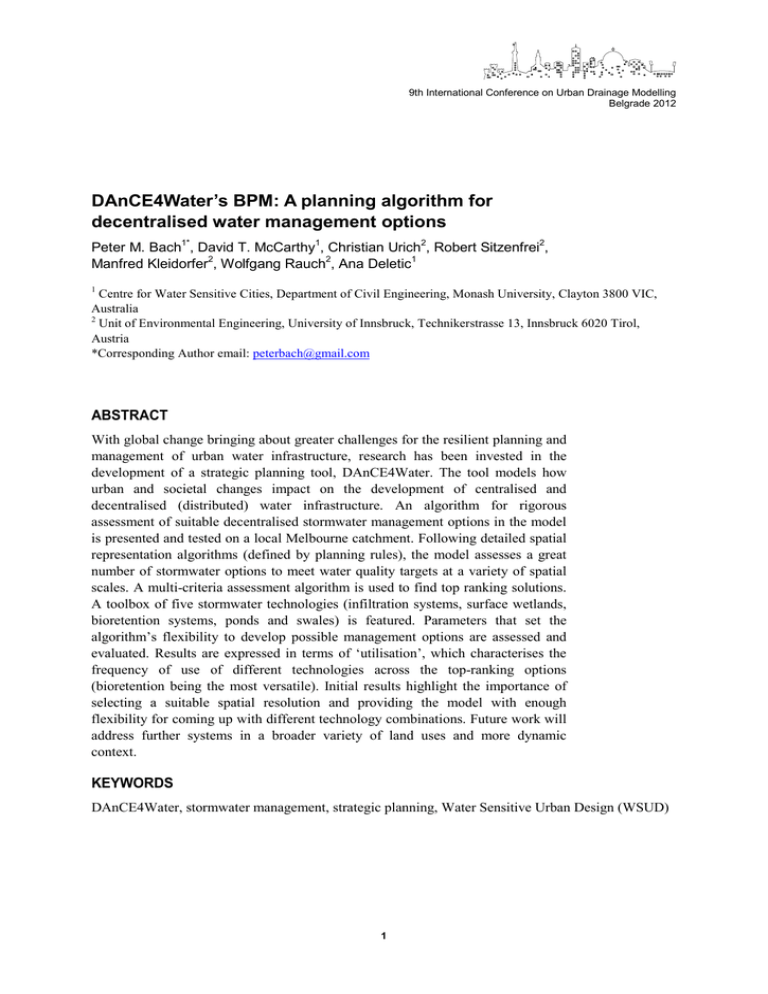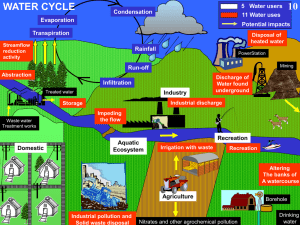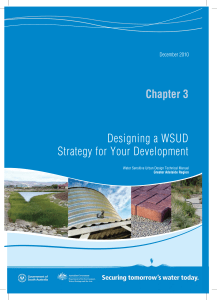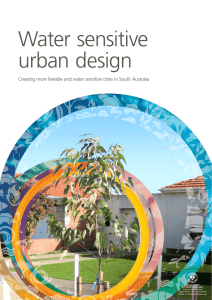DAnCE4Water’s BPM: A planning algorithm for decentralised water management options
advertisement

9th International Conference on Urban Drainage Modelling Belgrade 2012 DAnCE4Water’s BPM: A planning algorithm for decentralised water management options Peter M. Bach1*, David T. McCarthy1, Christian Urich2, Robert Sitzenfrei2, Manfred Kleidorfer2, Wolfgang Rauch2, Ana Deletic1 1 Centre for Water Sensitive Cities, Department of Civil Engineering, Monash University, Clayton 3800 VIC, Australia 2 Unit of Environmental Engineering, University of Innsbruck, Technikerstrasse 13, Innsbruck 6020 Tirol, Austria *Corresponding Author email: peterbach@gmail.com ABSTRACT With global change bringing about greater challenges for the resilient planning and management of urban water infrastructure, research has been invested in the development of a strategic planning tool, DAnCE4Water. The tool models how urban and societal changes impact on the development of centralised and decentralised (distributed) water infrastructure. An algorithm for rigorous assessment of suitable decentralised stormwater management options in the model is presented and tested on a local Melbourne catchment. Following detailed spatial representation algorithms (defined by planning rules), the model assesses a great number of stormwater options to meet water quality targets at a variety of spatial scales. A multi-criteria assessment algorithm is used to find top ranking solutions. A toolbox of five stormwater technologies (infiltration systems, surface wetlands, bioretention systems, ponds and swales) is featured. Parameters that set the algorithm’s flexibility to develop possible management options are assessed and evaluated. Results are expressed in terms of ‘utilisation’, which characterises the frequency of use of different technologies across the top-ranking options (bioretention being the most versatile). Initial results highlight the importance of selecting a suitable spatial resolution and providing the model with enough flexibility for coming up with different technology combinations. Future work will address further systems in a broader variety of land uses and more dynamic context. KEYWORDS DAnCE4Water, stormwater management, strategic planning, Water Sensitive Urban Design (WSUD) 1 1 INTRODUCTION Urban water management has significantly evolved in the last decade towards more integration, greater diversity of technologies (central- and decentralised) and more decision-factors (e.g. social, economic, environmental) (Rauch et al., 2005, Brown et al., 2009). Planning and management of water infrastructure, however, needs to become more resilient in light of growing population, rapid urban expansion and unpredictable climate. The use of models in planning and design is becoming more widespread and uptake of integrated urban water models in practice is slowly underway (Bach et al., in preparation). Despite this progress, we lack tools that can support growing interdisciplinary collaboration in planning of urban water infrastructure as well as model complex urban dynamics and its relationship with urban water infrastructure. The expansion of central water supply and sewer systems with a growing urban environment has been the subject of recent modelling research (Sitzenfrei et al., 2010, Urich et al., 2011). Recent unpublished work analysing Melbourne’s centralised systems also reveals significant correlation of network growth with urban expansion and changing demographics. How these influence planning and implementation of decentralised systems (in particular water sensitive urban design – WSUD) has, however, never been investigated in a modelling context. As such, the aim of this study is to present work to date on a model algorithm for rigorous planning and assessment of decentralised stormwater management options in a local urban catchment in Melbourne, Australia. DAnCE4Water (Dynamic Adaptation for enabling City Evolution for Water) is a strategic planning tool that comprises three modules: Societal Transition Module (STM) (focussing on societal dynamics and reported in detail by (De Haan et al., 2012)), Urban Development Module (UDM) (modelling dynamic changes of cities – see (Urich et al., 2012)) and Biophysical Module (BPM) (planning and adapting urban water infrastructure). The model receives input scenarios (e.g. policy experiments, exploratory experiments, ‘what-if’ questions) and encourages stakeholders to partake in participatory modelling. Figure 1. Overview of the DAnCE4Water's Biophysical Module 2 This paper focuses on the Biophysical Module (BPM), which is responsible for the spatial representation, planning, design and implementation of urban water infrastructure. The BPM uses the information provided by scenario and other modules on urban demographics and societal system to implement suitable infrastructure and adapt them in response to significant perturbations in the broader urban environment. Each run of the BPM follows five key steps from processing input data; spatial representation and infrastructure planning to performance assessment (see Figure 1). The paper presents work to date on an algorithm for finding suitable WSUD options in an urban catchment in Melbourne, Australia (up to Step 4 in Figure 1). Flexibility and sensitivity of the algorithm is assessed. 2 2.1 METHODOLOGY Data Set Geographic data (raster grids of land use, population, soil infiltration, elevation) was sourced for a local urban catchment in Melbourne’s south-eastern suburbs. Scotchman’s Creek catchment is primarily a residential catchment with local pockets of other land uses including larger areas of open space. The catchment has undergone significant urban development of varying urban densities. As such, it is ideal for investigating different scales of water management and of a reasonable spatial area for testing model algorithms. Note that this study will only focus on water management in residential districts. Adjacent open spaces will serve as hosts for neighbourhood and precinct-scale water management. 2.2 Spatial Representation Algorithms Geographic data is processed and aggregated to a coarse grid of building blocks (resolution determined by modelling aims, user preference and computational capacity – ranging from 100×100m to 1km×1km). Each block contains detailed information about the local area of the catchment and can be regarded as a neighbourhood within the region. This information is added to and update in each block as the simulation progresses, from areal proportions of different land use, total population and soil infiltration rate (after initial data processing) to total residential allotments, local street widths, water demand or number of streetscape WSUD systems (in later steps). The architectural detail of the urban form is necessary for the planning of WSUD systems and is obtained from rules set by planning schemes and building regulations for the region – here the Planning Provisions for Victoria (DPCD, 2006). An insight into how these rules are incorporated into an algorithm is provided in a previous study (Bach et al., 2011). The algorithm for residential districts has since been improved and tested on real-world data. The model also relates each individual block to its neighbours and the larger drainage basin by delineating flow paths using a well-known method (O'Callaghan and Mark, 1984). This information provides detail about the sub-basin structure of the input map, which sets the boundary conditions for decentralised system design and water management targets. 2.3 Planning of WSUD Options The WSUD planning algorithm is subdivided into three steps: (1) Assessment of Opportunities for WSUD implementation, (2) Construction of WSUD Options and (3) Evaluation of WSUD Options. WSUD implementation is considered at four different scales: within each block, lot-, street- and neighbourhood-scale systems are assessed and larger systems at the precinct scale may service several blocks along the same flow path. Design is based upon simple WSUD system sizing curves (which are fed into the model and can be easily replaced), which can either be sourced from published literature 3 or created using tools such as the Model for Urban Stormwater Improvement Conceptualisation (MUSIC) (eWater, 2011) and local climate data. Design also considers space for system maintenance, setbacks, safety and amenity prescribed by state-of-the-art. 2.3.1 Assessment of Opportunities for WSUD Implementation Available space (from spatial algorithms) is compared with required system size to meet required water management targets (e.g. pollution or hydrological targets) using the local design curves. A user-defined number of system types are checked at each scale within each block and each sub-basin of blocks (illustrated in Figure 2). Lot-scale systems are designed to service all on-site impervious area of the lot. However, the degree of lot scale implementation within a block is allowed to vary between none to all houses in the block (at a user-defined increment). Remaining untreated areas are considered at the next immediate scale (i.e. streetscape, etc). Systems considered at street, neighbourhood and precinct scales service varying portions the remaining untreated impervious area (e.g. 0% to 100% at user-defined increments). Precinct-scale design uses flow path and sub-basin information to identify all blocks and their untreated impervious areas upstream of the design location (see in Figure 2). The outcome of this first step is a wide range of system designs to treat different amounts of impervious areas in the sub-basin at different scales. 2.3.2 Construction of WSUD Options Urban Form Management Targets Design Curves & Rules Lot Scale implementation of systems in x% of allotments Shortlist ... ... ... Street/Neighbourhood Scale servicing x% of untreated allotments and public areas Precinct Scale servicing x% of entire untreated upstream region Shortlist ... ... ... Shortlist ... ... ... Block Options Precinct Options BASIN MANAGEMENT OPTIONS ... Realisation 1 Realisation 2 Realisation 3 Realisation N Basin/Regional Scale Applies water management option to achieve a specified target for a % of its total region. Realisations are generated using semi-randomised approach. Figure 2. Planning Algorithm for Placement of Decentralised Water Management Options 4 Using the substantial list of management options established previously, the second step uses a partly systematic, partly randomised approach to piece together combinations of systems into management options for each basin in the region. Lot-, street- and neighbourhood-scale opportunities are first systematically combined to provide a myriad of within-block options (a maximum of one technology is used at each scale in each configuration). Each of these local options is scored using a multi-criteria assessment (MCA) framework (explained in the next section). All scored options are sorted into different bins representing the overall degree of local treatment they provide. The top scoring 5% of options in each bin are retained while the rest are discarded leaving a reduced number of highly effective local management options. The randomised approach is used to construct possible system configurations for the entire basin (‘basin management options’ in Figure 2); starting at the most upstream location, a possible precinctscale system (‘none’ is also an option) is randomly selected. Top ranking within-block options (from randomly chosen bins) are subsequently chosen to infill the additional untreated impervious area (‘none’ once again being an option). The choices at each position in the basin are adjusted to account for the already serviced areas. The algorithm proceeds to the downstream-most location of the basin. The process is repeated 1,000 times to produce an array of different options that will treat ‘none’ to ‘all’ of the impervious area in the catchment. 2.3.3 Evaluation and Choice of WSUD Options To decide upon a final water management option, the model runs the second pass MCA for each combination to narrow down the 1,000 designs to a few candidates. Four criteria are considered: technical, environmental, economic and social. In each criterion, individual technologies are ranked to a number of metrics on a scale from 0 to 5 depending on expert opinion. A scoring matrix was adapted from the DayWater Multi-Criteria Comparator (Ellis et al., 2008) for the selected WSUD technologies (bioretention scores were derived from a combination of similar systems). The framework is one of few existing MCAs for WSUD technologies and is informed by expert opinion. Future work will develop a unique framework that more closely relates to the contexts, in which DAnCE4Water will be used and will incorporate more recent knowledge about the perceptions of WSUD. The multi-criteria scores only apply to individual technologies and these have to be combined to determine an overall score for each management option. As such, sub-scores are weighted according to the imperviousness that each system serves. These are added to determine criterion and total scores using a weighted-sum model (Triantaphyllou, 2000). The final options are reduced to a number of topranked alternatives (here the Top 10). In a dynamic DAnCE4Water simulation, one of these 10 options is chosen based on weighted probabilities for implementation at the current time period. For the current study, the variability of these ten options is explored. 2.4 Simulation Scenarios & Sensitivity Testing The planning algorithm was tested on Scotchman’s Creek Catchment (Figure 3), that is a rather typical 1000 ha residential area of Melbourne (average imperviousness of approx. 40%). Pollution management targets for system design were set to meet Total Suspended Solids, Total Nitrogen and Total Phosphorus load reductions of 80%, 30% and 30% respectively. Table 1 summarises five different WSUD technologies featured at different spatial scales in the simulation, their maximum allowable size (to prevent unrealistic design outcomes) and their criteria sub-scores for the scoring matrix used. For the current study, equal weightings among criteria were assumed when calculating the total score. 5 Table 1. Chosen Scales for WSUD Technologies, maximum areas for design and criteria sub-scores Technology Biofilters/Bioretentions (BF) Infiltration Systems (IS) Ponds & Basins (PB) Swales (SW) *** Surface Wetlands (WSUR) Spatial Scales* L S N P - Max. System Area [m2] 5,000 5,000 10,000 600 10,000 Un-weighted Criteria Sub-scores** Technical Environ. Economic Social 3.60 3.60 4.50 3.50 2.80 3.00 2.50 2.50 3.40 2.60 3.50 3.50 3.00 3.80 4.00 2.75 3.40 3.20 2.50 4.00 * L=Lot, S=Street, N=Neighbourhood, P=Precinct ** The scores range from 0 to 5 and represent the average score across all metrics in that criteria group *** Swale implementation is also limited by a minimum nature strip width requirement of 2m Discussion will focus on the sensitivity of model outputs for variations in: (1) size of Blocks, using 500m and 1km resolutions, and (2) the increment set for application of systems at each scale using increments of 10%, 25% and 50% (e.g. if the increment is 25%, this means that a WSUD system can either be ‘implemented in’ or ‘implemented to treat’ 25%, 50%, 75%, or 100% of ‘houses’ or ‘all impervious area’, respectively). Note that the same increment was applied across all scales for each of the three options tested. 3 RESULTS & DISCUSSION 3.1 Spatial Data Output The model writes the information contained in each building block as a shape file output, which can be viewed in any GIS program. Figure 3 (b and c) shows maps of imperviousness and elevation with flow paths for Scotchman’s Creek catchment for 500m x 500m building block size. The original data is shown alongside (in Figure 3a). Areas of high residential imperviousness are primarily located in the southern parts of the catchment. Drainage paths are towards the south-western region of the catchment (‘Parks& Garden’ and ‘Services & Utility’ land uses patches in Figure 3a) and are correctly reproduced by the model. (a) Land Use (c) (b) Elevation [m] Residential TIF Flow Path Arrow Figure 3. Scotchman's Creek Catchment Simulation for 500m building block size, (a) land use input data, (b) residential total impervious fraction (TIF) and (c) flow paths and elevation 6 3.2 WSUD Options & Utilisation of Various Technologies The model outputs is a spreadsheet containing details of a complete water management strategy (i.e. location, system size, scale, etc.) for each of the top ranked options. In order to assess not only this large volume of results in an efficient manner but also the sensitivity of different model parameters, a metric that could provide an overview of water management in the catchment was required. As such, ‘Utilisation’ of each technology was defined as the proportion of total treated imperviousness that it treats (relative to all other technologies used and normalised to the option’s overall treatment efficiency). It was calculated for the top ten options out of the 1,000 realisations in each scenario and plotted against user-defined increment and block size (see Figure 4). Additionally, Table 2 presents mean value and coefficient of variation of utilisation for each case. This metric was found to be useful as it provided an efficient way of condensing the large volume of model output and assessing sensitivity of key model parameters. Trends shown in Figure 4 reveal that bioretention systems are relatively widespread in most of the topranking options (utilisation averaging around the 50% mark). This is partly due to the system’s advantage of a small footprint, great flexibility and its widespread preference, evidenced in the four evaluation criteria. The use of infiltration was limited due to the additional nature strip width requirements (the planning algorithm varies this stochastically between 1 and 3m) and poor infiltration capacities in certain areas of the catchment, respectively. Swales were also not that prominent due to their large size in comparison to wetlands and bioretention (for the same performance target). Utilisation values of ponds and surface wetlands were relatively similar, the latter being smaller. This is partly due to space constraints within the catchment with only several local pockets of open space available. 1 0.9 Utilisation 1 50% increments 25% increments 10% increments 0.9 0.8 0.8 0.7 0.7 0.6 0.6 0.5 0.5 0.4 0.4 0.3 0.3 0.2 0.2 0.1 0.1 0 0 0 1BF 500m x 500m IS 2 SW 3 PB 4 WSUR 5 6 0 System Type BF 1 1000m x 1000m 2IS SW 3 PB 4 WSUR 5 6 System Type Figure 4. Utilisation of different Systems in Top-Ranking Options for Scotchman's Creek Catchment (at 10%, 25% and 50% user-defined increments for 500m x 500m and 1000m x 1000m Blocks) The influences of block size and increment choice on ‘utilisation’ are judged as quite sensitive. A larger block size and larger increment leads to significant variation in results. Using 1000m building blocks produces higher values of CV. A coarser resolution might not accurately reflect the variability in urban form (as the planning algorithm only runs at the block-level) and consequently overshadows otherwise opportunistic systems such as infiltration and swales (see Figure 4). This suggests that the 1000m resolution might be too coarse to produce any useful results for this particular case study. 7 Further work is needed to determine the optimal block size for a given catchment size that should include modelling of the performance of the WSUD options. Decreases in CV and scatter of points are observed with decreasing increment (Table 2). This convergence can possibly be interpreted as a typical or recommended level of ‘utilisation’ for each system type if they are to be used in conjunction with each other in this particular catchment. Not surprisingly, smaller increments lead to a larger variety of designs from which the model can sample when developing management options. It should be noted that the scenarios presented in Table 2 were for options that meet the given target for the entire basin (e.g. a case of a new development where WSUD is regulated and the given pollution targets must be met for the entire development). The distribution of systems across the catchment will become far more limited if the targets are to be meat at only a fraction of the basin (e.g. a retrofitting case). Table 2. Mean and Coefficient of Variation of ‘Utilisation’ for each WSUD technology at different increments and block sizes System Biofilters/Bioretention Infiltration Systems Swales Ponds & Basins Surface Wetlands 3.3 μ CV μ CV Μ CV μ CV Μ CV 500m x 500m Block Size 50% incr. 25% incr. 10% incr. 0.370 37.8% 0.016 83.2% 0.002 133.9% 0.468 39.4% 0.144 92.3% 0.536 18.1% 0.016 65.9% 0.005 78.1% 0.224 42.3% 0.219 39.7% 0.525 13.8% 0.070 43.4% 0.004 78.3% 0.331 22.5% 0.133 25.5% 1000m x 1000m Block Size 50% incr. 25% incr 10%incr 0.379 40.5% 0 0.0% 0 0.0% 0.562 19.6% 0.059 160.6% 0.418 33.4% 0.003 155.1% 0 0.0% 0.500 26.5% 0.079 120.6% 0.550 29.0% 0 269.2% 0 288.8% 0.380 54.9% 0.069 121.4% Future Work and Implementation The paper has presented only a small snapshot of a substantial collection of output provided by the model. Each combination output file is spatially explicit and indicates systems implemented in each building block at each scale. Values of ‘utilisation’ presented earlier provide a general indication of feasibility of different water management technologies for the catchment, but consultation of detailed outputs will also indicate opportune locations in the catchment. It was found that systems were quite spatially distributed across the Scotchman’s Creek catchment with the highest concentration near the outlet in the south. The northern, upstream-most region of the catchment was also found to contain very low to no implementation of technologies. Translation of such results into practical measures, however, will require a greater number of simulations as well as a participatory setting where inputs are provided by various experts. The algorithm currently does not consider existing systems in the area, which could contribute to achieving management targets or reduce the available infrastructure space. The present state of Scotchman’s Creek catchment features several lot-scale systems as well as a series of larger wetlands in its southern region, which are not considered (although the model suggests placing ponds and wetlands in these areas in most of its options). This aspect will be addressed in near future so that the model can be applied in a dynamic and ‘retrofit’ context. 8 4 CONCLUSION The following study has presented the initial results of a planning algorithm for decentralised water management options that forms part of DAnCE4Water’s Biophysical Module. The approach considers a variety of scales and technologies and uses detailed urban planning information to determine urban form and opportunities for various water management measures. A semi-randomised approach is used to piece together a plethora of management options, each of which is evaluated in a multi-criteria context. Results, expressed in terms of ‘utilisation’ indicate differing levels of opportunities for five different systems for managing water quality in residential areas and open spaces of Scotchman’s Creek catchment. Future work on the model will also encompass algorithms for non-residential zones and the addition of more decentralised technologies (for wastewater and water supply) to the existing toolbox. The model will also need to simulate implementation and modification of decentralised systems into the dynamic urban environment as the city, legislation and social paradigms change. This dynamic will also be one of the key connections between the biophysical and social systems in DAnCE4Water. Extensive testing on Scotchman’s Creek catchment will continue, entailing the possibility of a second case study in future. 5 ACKNOWLEDGEMENTS The research leading to this paper was funded by the European Union through its Seventh Framework Programme project ‘PREPARED: Enabling Change’ and the Australian Government’s Department of Industry, Innovation, Science, Research and Tertiary Education. 6 REFERENCES BACH, P. M., RAUCH, W., MIKKELSEN, P. S., MCCARTHY, D. T. & DELETIC, A. in preparation. A Critical Review on Integrated Urban Drainage Modelling and Beyond. BACH, P. M., URICH, C., MCCARTHY, D. T., SITZENFREI, R., KLEIDORFER, M., RAUCH, W. & DELETIC, A. 2011. Characterising a city for integrated performance assessment of water infrastructure in the DAnCE4Water framework. 12th International Conference on Urban Drainage (12ICUD). Porto Alegre, Brazil. BROWN, R. R., KEATH, N. & WONG, T. H. F. 2009. Urban water management in cities: historical, current and future regimes. Water Science & Technology, 59, 847-855. DE HAAN, F. J., FERGUSON, B. C., DELETIC, A. & BROWN, R. R. 2012. Exploring Scenarios for Urban Water Systems Using a Socio-Technical Model. 9th International Conference on Urban Drainage Modelling. Belgrade, Serbia. DPCD 2006. Planning Scheme of Victoria. Victorian Planning Provisions. Melbourne, Victoria: Department of Planning and Community Development. ELLIS, J. B., REVITT, D. M. & SCHOLES, L. (eds.) 2008. The DayWater Multi-Criteria Comparator, London, UK: IWA Publishing. EWATER 2011. MUSIC by eWater, User Manual, Melbourne, Australia, eWater. O'CALLAGHAN, J. F. & MARK, D. M. 1984. The Extraction of Drainage Networks from Digital Elevation Data. Computer Vision, Graphics, And Image Processing, 28, 323-344. 9 RAUCH, W., SEGGELKE, K., BROWN, R. & KREBS, P. 2005. Integrated Approaches in Urban Storm Drainage: Where Do We Stand? Environmental Management, 35, 396-409. SITZENFREI, R., MÖDERL, M. & RAUCH, W. 2010. Graph Theory Based Approach for Generating Virtual Water Distribution Systems in the Software VIBe. Water Science & Technology, 10, 923-932. TRIANTAPHYLLOU, E. 2000. Multi-Criteria Decision Making Methods: A Comparative Study, Dordrecht, Kluwer Academic Publishers. URICH, C., BACH, P. M., HELLBACH, C., SITZENFREI, R., KLEIDORFER, M., MCCARTHY, D. T., DELETIC, A. & RAUCH, W. 2011. Dynamics of cities and water infrastructure in the DAnCE4Water model. 12th International Conference on Urban Drainage (12ICUD). Porto Alegre, Brazil. URICH, C., SITZENFREI, R., KLEIDORFER, M., BACH, P. M., MCCARTHY, D. T., DELETIC, A. & RAUCH, W. 2012. Evolution of Urban Drainage Networks in DAnCE4Water. 9th International Conference on Urban Drainage Modelling. Belgrade, Serbia. 10








